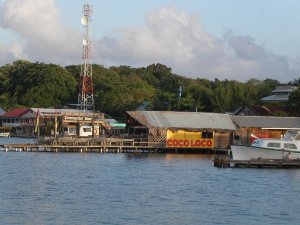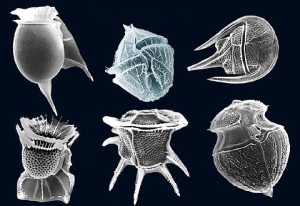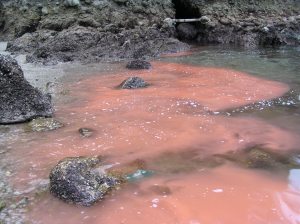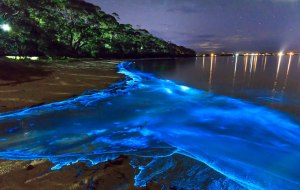Off the coast of Honduras sits a small beautiful island called Utila. Less known, and thus less-overrun, than its famous big sister Roatan, Utila sits in the middle of the largest coral reef system outside the Great Barrier Reef in Australia. Accordingly, the snorkeling and scuba diving in Utila is second-to-one and far, far cheaper and more accessible.
Though it may be more now, my Honduran friends and I have gone to Utila several times and spent just a few hundred dollars for four or five days of paradise. (That’s without airfare; we take a small boat from the Honduran coastal city of La Ceiba.)

There are beautiful and nearly deserted beaches, bars on long piers and in treetops (not kidding!), and small, locally owned restaurants serving up a variety of cuisines. In addition to local fare, you can find Indian, Italian, Mexican, and pub food.
The diving in Utila is breathtaking. My friends and I rent snorkel gear for around $3/day and enter the water off the coast of a friendly hotelier for free as long as we purchase a few beers from the bar. As if we wouldn’t. (Scuba will cost much more, of course, but requires certification and the hiring of a boat and trained staff.)

(For more info on Utila, read this, this, this, or one of these semi-official pages)
On one particular day of snorkeling, I was treading peacefully in water about five meters deep when I saw a bright flash off to my right side. I turned to look and saw only a strange dark grey oval about ten meters away. A closer examination revealed eyes on the side of the oval. Then I noticed some black feather-like brushes fluttering on both sides and on the top and bottom. It was a fish of some kind, looking at me head-on.
I swam to get a closer look when, perhaps frightened by my approach, it turned and swam slowly away. As it did so, the oval elongated, and elongated, and elongated. It’s color lightened to a highly reflective silver. I then realized why I’d seen a flash.
And I also realized that I was staring at a huge barracuda.

After the initial jolt of terror, exhilaration set in. Barracudas are fairly shy so this was a special treat and I resolved to enjoy it as long as I could, giving cautious chase as the fish eventually accelerated out of view. (This was a foolish move, I was later told by more experienced divers.)
When it had disappeared into the depths, I surfaced to revel in the excitement with my friend. “VISTE ESA BARRACUDA??!!” Yep, I sure did. I thought that would be the highlight of the trip, but little did I know, I would see a spotted eagle ray the next day. Like I said, paradise.

We selected a seafood place for dinner that night because of course we did. As I scanned the menu, I was barely listening as the waiter ticked off the specials until I heard, “un filete de barracuda…” I’d never heard of barracuda steak! I am of the obnoxious personality type that if something sounds strange or exotic, I will almost always want to try it. That, coupled with the fact that I’d seen one that very morning, made the decision easy, “Quisiera el filete de barracua. Bien hecho, porfa.”
It was okay. Nothing spectacular. A bit more tender and flaky than tuna or Mahi Mahi steak, and a bit more greasy also. It had a very mild fishy flavor, not so much that it repulsed me, but enough that I probably wouldn’t choose it again. All good. Check that off the list. We spent some time at one of the more clubby bars that night, Coco Loco I think it was, and turned in pretty early.

I woke up in the middle of the night and spent some time on the toilet. For some travelers, this is just something they deal with occasionally, but I’ve never struggled much with traveler’s diarrhea. I drink the local water pretty much everywhere I go and haven’t had much of a problem. I figure my gut is already inoculated with a rich global population of microbes. It’s like the UN down there. Well, I guess that night the security council was in emergency session and about to order some bombing raids. It wasn’t bad, just a couple hours of discomfort and I was back to sleep. The next day, I was pretty much 100% and I ate normally. No big deal.
Within a week, I had returned to Queens and going about my life. The symptoms crept up so slowly that it was weeks before I put it all together. After a long run, my legs would ache. Duh, of course they would. I became sensitive to cold food and drink. I guessed it was time to switch to Sensodyne tooth paste.
It was only when my legs started aching for no apparent reason that I started to take notice. It happened more and more. Eventually, any time I was lying down, my legs hurt. It was the muscles, not the joints, and mostly my thighs and butt, but less so the hamstrings and calves. It was worst when I was supine (face up), but only slightly better when I was prone. Falling asleep became difficult. What the hell was going on?
Like most foolish men, it didn’t even dawn on me to consult a doctor. I just went about my business. I ran less because that made things worse. The eureka moment came when I was at a Greek restaurant with my husband and I mindless took a sip of water and suddenly spit it back into the glass. “Jesus! They gave me hot water! It’s scalding!” I had barely finished the sentence when I noticed the ice floating in the glass.

It wasn’t just sensitivity; cold water felt HOT. Very cold water felt boiling. It was time to do some research. Of course, WebMD told me that I had brain cancer so I moved on quickly. The weird cold-hot sensation was the key element that led me to the answer. On the list of symptoms, most of which I had, was one strange item: red spots on the tongue. I went to the bathroom mirror immediately. How had I not noticed before that my tongue was covered with tiny red polka dots?! (In fairness, how often do we really look at our tongues?)
Ciguatera poisoning. That’s what I had. Although there are other symptoms (read more about it here), among the most common are cold-feeling-as-hot on the tongue (check.), red spots on the tongue (check.), and achy muscles (check.), especially in the legs (check.), worse after exercise (check.). Although the descriptions included some very frightening possibilities: years of symptoms, crippling pain, severe GI disturbances, and even paralysis, most cases are very mild and it was clear that mine was, too. The symptoms subsided gradually and had disappeared within four months.
(There is a blog all about living with chronic ciguatera intoxication. The author even wrote a book about it!)
How does one contract ciguatera poisoning? Ciguatera is a toxin made by a couple species of dinoflagellates, tiny one-celled creatures from the informal group of organisms known as protists. Dinoflagellates and other protists comprise a large chunk of plankton, the microbiota at the very base of the ocean food chain. Ocean water is teeming with plankton, especially in the top ten or twenty meters. A different kind of dinoflagellate is famous for causing red tide during algal blooms (which can sicken people through a different toxin). Other famous dinoflagelates cause the fascinating luminous phenomenon in places like Bioluminescent Bay in Puerto Rico.



But I don’t remember eating any dinoflagelates. And if they are present in all ocean water, why aren’t we all getting ciguatera poisoning every time we swallow some seawater? The key to ciguatera poisoning is bioaccumulation.
Bioaccumulation occurs when some molecule is produced low in the food chain and spreads to other organisms through consumption, increasing in concentration as it makes its way to the top of the food chain. This occurs when the ingesting animals have no way to process the toxin and so it builds up in their body each time they consume it, usually in their liver. If this happens in three or four links of the food chain (“food web” is the more accurate term), the toxin can reach higher and higher concentrations each step. By the time a toxin reaches an apex predator, the concentration may be high enough to be poisonous and it may spill out from the liver to things like muscle tissue.

Barracudas are apex predators, which means they are at the top of their food web with no known predators. The only animals that eat them are humans, and only foolish ones at that. Barracudas are common in tropical waters all over the globe, especially in coral reef systems. Despite this, you will not find locals eating barracuda meat. Of course barracuda won’t make you sick every time. It wouldn’t be served in restaurants if it were always or even usually toxic. It only rarely sickens, but it’s often enough that local people know not to risk it.

And what of the ciguatera toxin itself? Ciguatera belongs to a family called the polyether toxins. We do not know the function this molecule performs in the dinflagelates that make it. It is highly unlikely that it is an evolved toxin used to convince animals to avoid eating them, like a poisonous tree frog or a toxic plant. Microbes don’t work that way because there’d be no way to “train” the animals anyway. Plankton eaters can’t see what their eating.

Whatever the toxin does in the dinoflagelates, it is toxic to many animals because it interferes with the voltage-gated sodium channels that neurons use to fire action potentials. In other words, it’s a neurotoxin that inhibits a neuron’s ability to communicate with other cells. By the way, this is the very same mechanism of action as tetrodoxin, the sometimes lethal molecule found in improperly prepared pufferfish. Thankfully for me and thousands of others, ciguatera toxin is not nearly as potent as tetrodotoxin. But it is unnerving that they do the same thing.
Even more unnerving is that the ciguatera toxin isn’t destroyed by cooking. I had ordered my barracuda steak well done, in a naive attempt at food safety. That clearly made no difference. Ciguaterra is a toxin, not a bacterium, and a heat-resistant one, it turns out.
The strange symptoms of ciguatera have to do with where it hangs out in an animal’s body. Ciguatera toxin is hydrophobic, which means it is more soluble in fats and oils than it is in water. Because of that, it hangs out in fatty tissues, including the fatty insulation that covers long neurons. In humans, this explains the sore muscles and strange thermo-sensation problems.

Why don’t the barracuda and other members of the food web get sick? Well, first of all, we can’t say for sure that they don’t experience some symptoms. How would we know? Secondly, they have likely evolved anti-toxins or other defenses against ciguatera toxin that allows them to tolerate high doses by storing it safely in fatty deposits around their muscles. (Like clownfish that hang out in highly poisonous sea anemones.)
I ate some of those ciguatera-filled fatty deposits that warm night in Utila.
So what is the lesson here? The first one is to avoid eating marine apex predators, particularly those in tropical reef systems. Ciguatera toxin is just one of a whole host of toxins that are known to circulate in these systems and bioaccumulate up the food chain. Just like with red tide, the toxin-producing species aren’t always in full bloom, but, unlike red tide, these species are not visibly conspicuous so there is no way to know when it is dangerous to eat reef fish and when it is not.

The second lesson is to always listen to the locals and avoid eating what they don’t eat. Locals are the bearers of centuries of accumulated wisdom. To be poetic, just as ciguatera toxin accumulates up the food chain, knowledge of its dangers accumulates down through the generations. The natives of Utila (who speak an interesting English creole language) would never eat a barracuda and neither should you. While its true that almost any food can sicken you, carnivorous fish in tropical reef systems carry all the usual risks plus the toxin-bioaccumulation danger.
Like everything else in a coral reef system, the rule with reef fish should be, “Look but don’t touch.”

-NHL (@nathanlents)

fascinating read! did not know ciguatera poisoning was a thing, or that barracudas are shy (would’ve expected the opposite!).
LikeLike
Thats what I hear. But if they’re threatened, they strike. Google image barracuda bite for some gnarly wounds. Thanks for the kind word!
LikeLike
Did you continue to run during your 4 months of ciguatera symptoms or did you lay off until you felt better? I am trying to figure out if i want to push my exercise even though it induces my ciguatera (12 days in now). Much like you, symptoms are not as strong as some people’s.
LikeLike
I laid off running for a couple weeks and then after that, just powered through. Thanks for reading! Where did you pick up the CGX?
LikeLike
just wanted to thank you for this. learning about ciguatoxin to study for boards in medical school, and this story is textbook. Awesome to hear it in words by someone who really experienced it. Much appreciated
LikeLike
Glad to hear it!
LikeLike
Very interesting reading, I’m a marine biologist from Puerto Rico, and I’m very familiar with ciguatera. I met once a a medical doctor that recommended treating ciguatera cases with drugs that help lower cholesterol, specifically drugs that block the disrupt the cholesterol role in digestion. The body secretes some cholesterol to help digest fast, that is then reabsorbed in the intestines. The drug block reabsorption and therefore facilitate the excretion of secreted cholesterol plus the one ingested. Because the ciguatoxin is a fatty soluble molecule, he proposed that some of the toxin gets secreted and reabsorbed in the cholesterol digestive cycle. By blocking the reabsorption this drugs could accelerate the body detoxification process. I don’t know if clinical trials were performed, but hypothesis sound reasonable.
LikeLike
Hi Rafael – thanks for commenting! The drugs you’re describing sound like something called bile sequestrants. I remember learning about them in my Pharm class in graduate school but haven’t thought much about them since. It does make sense that they could slowly deplete the ciguatera because, as you say, it’s a hydrophobic molecule and fat-soluble molecules distribute in all hydrophobic compartments of the body, so some of it ends up in bile. Interesting!
LikeLike
comm. fished fl. 40 years never ate or sold these trash fish until 2000,fishouses love them they are cheap and can be fillet and sold as other fish .fraud. A.J. also filled with worms
LikeLike
Another reason to steer clear! Thanks for sharing.
LikeLike
Ciguatera survivor here, contracted in Culebra, Puerto Rico, a few years ago and spending time on Roatan now. Thought I should do a little research and came across your article. Ciguatera is a neurological disease and my worst symptoms that lasted for months were the phantom itching in unlikely places and random nerve tinglings. The last place you itch is the bottoms of your feet, sometimes mercilessly for hours, and especially after exercise. It took four months to mostly go away. The aching leg muscles and the hot/cold reversals were definitely the first clues; hard to forget the sensation of drinking a cold glass of water and feeling like I just drank hot tea! I definitely avoid the barracuda and kingfish now, and am skeptical about too much snapper and grouper, as the symptoms can easily be triggered again if not careful.
Thanks for bringing awareness to this not-so-rare but unknown disease! I’ve read that whole islands in the South Pacific suffer from it.
LikeLike